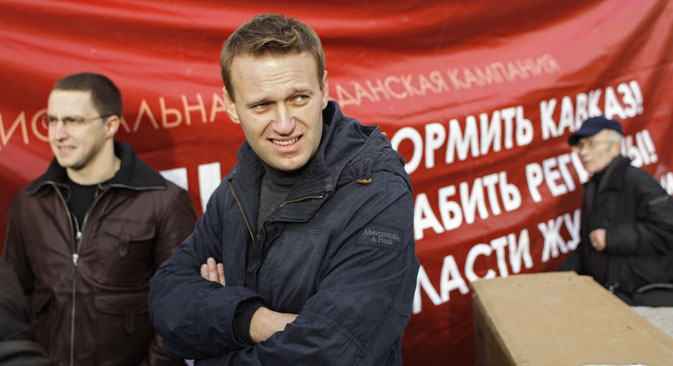
From the beginning, Navalny positioned himself as a candidate of the people – and that position influenced his entire campaign. Source: AP
Although opposition candidate Alexei Navalny did not win the election for Moscow mayor on Sept. 8, the tactics embraced by his upstart candidacy marked a sea change in the way campaigns in Russia are conducted. While fundraising and door-to-door canvassing are common tactics in the United States, they were basically unknown in Russia up to this point.
With only limited access to the national media, Navalny’s headquarters launched a campaign on social networks that gradually expanded offline. Navalny was not covered by state television channels, which was a major disadvantage, as more than 73 percent of Russians get their news from TV, according to surveys by the Levada Center polling agency.
Nevertheless, Navalny raised his awareness among the electorate from 69 percent in July to 81 percent by the end of August and his campaign managed to raise $3.09 million in donations from Russian citizens and recruit more than 15,000 volunteers.
This level of activism was unprecedented in Russian politics.
Ksenia, a business analyst at a major consulting company who volunteered on the Navalny campaign said she would do it again. "First,” Ksenia said, “campaigning was fun. A lot more people than I expected said ‘thank you,’ or ‘don't waste paper on us, we are already planning to vote.
Secondly, it is hard, physically and emotionally, because you give your energy to every person, smile at each one, try to quickly find a topic that resonates with each one. My goal was to reach everyone who passed by my intersection or who was in my subway car. Sometimes I only had enough time to pass out the flyers.
If we stopped for a minute at traffic lights or at a stop sign, I usually started a conversation with someone who didn't want to take the flyer. Besides that I talked to all of my friends and family, and kept trying up to the last minute to convince every one of them."
The Navalny team also promoted their candidate with more creative ideas. An online survey by Russian magazine Slon named the “Navalny Cubes” the most memorable part of the campaign. All volunteers who wanted to participate in the campaign received a cube from the campaign headquarters.
The six-sided metal frame was covered with stickers describing the main beliefs of the candidate. The campaign’s Web site gave easy-to-follow visual instructions on how to set up the cube as well as campaign tips.
Those who wanted to take a more passive role in the campaign could put Navalny stickers on their cars or bags and tune into regular campaign meetings online, broadcast live from the campaign office.
Election Day in Russia: Opposition surprises the ruling party
Moscow mayoral battle: Clash of political cultures
Martin Luther King’s legacy: No dream for Russian opposition
From the beginning, Navalny positioned himself as a candidate of the people – and that position influenced his entire campaign. Regular meetings with voters, volunteers and journalists as well as an informal way of speaking helped create the image of Navalny as a fresh political figure.
The Navalny campaign did not limit itself to encouraging people to vote for their candidate. The campaign also urged citizens to act as observers on election day. Navalny rose to prominence during the 2011 protests against election violations, and making sure elections were free and fair was one of his major talking points.
Partially as a result of this activism, the number of observers at the election was unprecedented. On election day, polling places across Russia were monitored by more than 250,000 people from all political parties, as well as thousands of non-affiliated observers and social activists.
Navalny also reached out to a more affluent crowd. The campaign hosted a dinner at Moscow’s Ritz-Carlton where tickets went for 7,800 rubles ($240).
Invitations to the event included a note stating: "The cost of the dinner is 7,800 rubles, all of which will go towards organizing the dinner and not to financing the election campaign. Payment should be made on the day of the dinner at the Ritz-Carlton by cash or card.”
At the event, investors, entrepreneurs and bankers listened to a presentation on Navalny's economic program given by well-known Russian economist Sergei Guriev.
After dinner, a question and answer session with Navalny was moderated by Arkady Ostrovsky, Moscow bureau chief of The Economist. For three hours, Ostrovsky along with the dinner guests asked the candidate pointed questions about his team, his plans to combat corruption, specific actions he would take should he win, his personal income and potential conflicts of interest.
These efforts gave Navalny 27.24 percent of the vote – a notable result for an opposition candidate in Russia.
Navalny volunteer Ksenia said that her desire to join the campaign wasn’t driven only by her enthusiasm for the candidate. “It wasn't a question of whether or not I would participate in the campaign,” Ksenia said. “There was a chance to create political competition in our country in order to give the current regime quality feedback. I couldn't let it slip away."
Ilya Klishin, political journalist for Slon, said that with its new tactics and its impressive results, the Navalny campaign has raised the bar for Russian elections, "[this campaign style] can be exported and scaled to other projects," Klishin wrote.
“Navalny and his staff did an excellent job of mobilizing their electorate for this election. Now they have a new challenge – to win the support of the majority before elections to the Duma.” The next elections for Russia’s national legislative body will be held in Fall 2014.
All rights reserved by Rossiyskaya Gazeta.
Subscribe
to our newsletter!
Get the week's best stories straight to your inbox